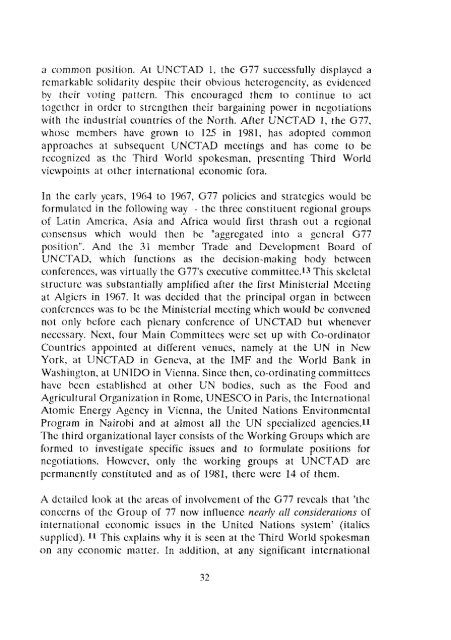ifda dossier 74 - Dag Hammarskjöld Foundation
ifda dossier 74 - Dag Hammarskjöld Foundation
ifda dossier 74 - Dag Hammarskjöld Foundation
You also want an ePaper? Increase the reach of your titles
YUMPU automatically turns print PDFs into web optimized ePapers that Google loves.
a common position. At UNCTAD 1, the G77 successfully displayed a<br />
remarkable solidarity despite their obvious heterogeneity, as evidenced<br />
by their voting pattern. This encouraged them to continue to act<br />
together in order to strengthen their bargaining power in negotiations<br />
with the industrial countries of the North. After UNCTAD 1, the G77,<br />
whose members have grown to 125 in 1981, has adopted common<br />
approaches at subsequent UNCTAD meetings and has come to be<br />
recognized as the Third World spokesman, presenting Third World<br />
viewpoints at other international economic fora.<br />
In the e:irly years, 1964 to 1967, G77 policies and strategies would be<br />
formulated in the following way - the three constituent regional groups<br />
of Latin America, Asia and Africa would first thrash out a regional<br />
consensus which would then be "aggregated into a general G77<br />
position". And the 31 member Trade and Development Board of<br />
UNCTAD, which functions as the decision-making body between<br />
conferences, was virtually the G77's executive committee.13 This skeletal<br />
structure was substantially amplified after the first Ministerial Meeting<br />
at Algiers in 1967. It was decided that the principal organ in between<br />
conferences was to be the Ministerial meeting which would be convened<br />
not only before each plenary conference of UNCTAD but whenever<br />
necessary. Next, four Main Committees were set up with Co-ordinator<br />
Countries appointed at different venues, namely at the UN in New<br />
York, at UNCTAD in Geneva, at the IMF and the World Bank in<br />
Washington, at UNIDO in Vienna. Since then, co-ordinating committees<br />
have been established at other UN bodies, such as the Food and<br />
Agricultural Organization in Rome, UNESCO in Paris, the International<br />
Atomic Energy Agency in Vienna, the United Nations Environmental<br />
Program in Nairobi and at almost all the UN specialized agencies.11<br />
The third organizational layer consists of the Working Groups which are<br />
formed to investigate specific issues and to formulate positions for<br />
negotiations. However, only the working groups at UNCTAD are<br />
permanently constituted and as of 1981, there were 14 of them.<br />
A detailed look at the areas of involvement of the G77 reveals that 'the<br />
concerns of the Group of 77 now influence near!)' all considerations of<br />
international economic issues in the United Nations system' (italics<br />
supplied). 11 This explains why it is seen at the Third World spokesman<br />
on any economic matter. In addition, at any significant international
















